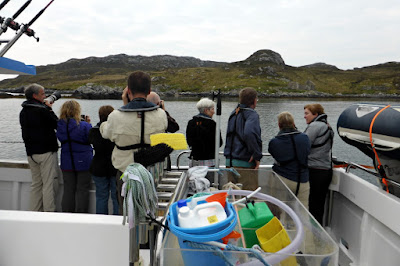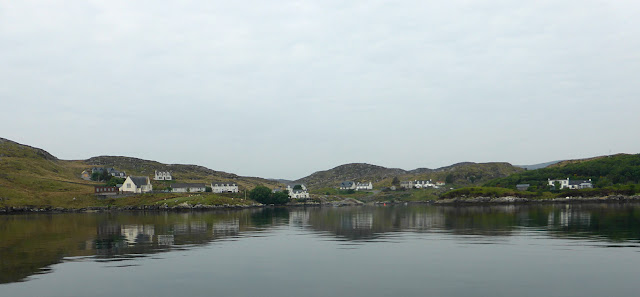We also braved the "scary" trail, and emerged into the back lawn.
Jonathan greeted a neighbor's pony.
Then our group was off to visit the Aigas Field Center,
where we paid a nighttime visit several days before to view the nocturnal pine marten. First, we were treated to a presentation by Sir John Lister-Kaye, which covered much of the natural and some political history of this part of Scotland. The "hills and heather" associated with the Highlands are a human creation, started by the cutting down of trees for shelter and fire. The grazing of sheep prevented anything from growing back, and the Highland Clearances pushed the human population to the coastline and beyond. The Victorian landlords deliberately kept their lands cleared of anything that would interfere with hunting the Big Three: red deer, grouse, and salmon. Sir John is dedicated to restoring the true nature of the Highlands as much as possible.
After the presentation we walked to the Scottish wild cat enclosure, making some friends along the way.
The wild cat quarters.
Scottish wild cats appear very similar to domesticated cats, with which they have hybridized. The Field Center is working on establishing a wild cat lineage by breeding only those animals with at least 80% wild genetics (how this is measured, I do not know).
 |
| Who are you? |
sometimes not.
 |
| Ahhhhh. |
 |
| Side view, actually. |
 |
| Front entrance. |
Inside, a map of the Center, whose grounds include the remains of Bronze and Iron Age habitation. (Click on the image to enlarge.)
On the way up the glen we saw plenty of brazen red deer,
 |
| Please, no pictures, I'm shedding my winter coat. |
The Mullardoch dam holds back a large lake, but the water that spins nearby turbines to generate electricity passes through over 5 km of tunnel to exit into Loch Benevean.
 |
| Behind the dam. |
 |
| Below the dam. |
This scheme allows the dam creating Loch Benevean to be much smaller than otherwise.
Joan birdwatching, and me looking unsure.
On our way back down Glen Cannich we stopped next to a bridge for more bird watching; I found a colorful spider on the bridge itself.
Another highland coo (or Heilan coo), a group favorite, but especially for Nadia.
Suddenly another roadside surprise materialized with snacks and beverages and hand-painted mugs from the Magnus House. Nadia is holding her highland coo calendar.
Dinner that evening wasn't at the Coul House, but at a local pub, the Allangrange Arms. Jonathan dressed for the occasion.
On our arrival the barman inquired from where we had each come. When Joan and I said Ohio, he called out, "O-H!" Joan and I, surprised, yelled back, "I-O!" to complete The Ohio State University call and response. It turned out he had spent some time in Columbus! The food was superb, as usual ... Jonathan knows how to pick 'em.
There was time for one final expedition to a misty Loch Kinellan the next morning, before heading to the airport.
At the parking area there is a monument to the men of the Black Watch Regiment who died in the Korean War, erected by a local man who'd served in that war.
At the loch we were entertained by coots, and a tufted duck,
but most especially by a horned grebe and her chick. My images aren't the sharpest, but I think you'll catch on.
Very snug.
A final sight before reaching the Inverness airport was this monument to the Scottish drovers.
In earlier times the highland cattle were led to market on foot, a long march. On the return the drovers stuck together to deter bandits, who knew the drovers now bore cash, while the dogs dashed home ahead of their masters, living notification of impending family reunions.
And then we flew home. The ten days since our arrival had been packed with activity, but Joan and I know there is still more to be experienced in the Highlands and Islands.
There was time for one final expedition to a misty Loch Kinellan the next morning, before heading to the airport.
At the parking area there is a monument to the men of the Black Watch Regiment who died in the Korean War, erected by a local man who'd served in that war.
At the loch we were entertained by coots, and a tufted duck,
but most especially by a horned grebe and her chick. My images aren't the sharpest, but I think you'll catch on.
 |
| Don't go too far! |
 |
| All aboard! |
A final sight before reaching the Inverness airport was this monument to the Scottish drovers.
In earlier times the highland cattle were led to market on foot, a long march. On the return the drovers stuck together to deter bandits, who knew the drovers now bore cash, while the dogs dashed home ahead of their masters, living notification of impending family reunions.
And then we flew home. The ten days since our arrival had been packed with activity, but Joan and I know there is still more to be experienced in the Highlands and Islands.














































































